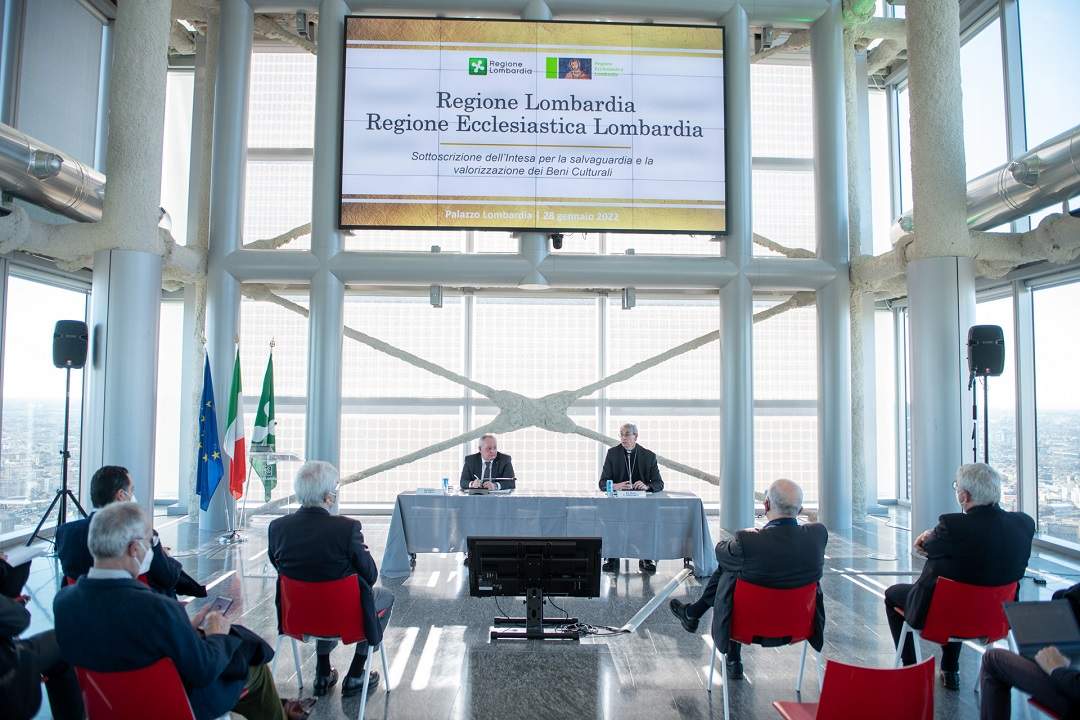To enhance and safeguard the very rich heritage of cultural assets of the Lombardy Ecclesiastical Region, which groups the dioceses of Bergamo, Brescia, Como, Crema, Cremona, Lodi, Mantua, Milan, Pavia and Vigevano.
This is the goal of the Memorandum of Understandingsigned by Lombardy Region’s Autonomy and Culture Councilor Stefano Bruno Galli and H.E. Msgr. Corrado Sanguineti, bishop of Pavia and Cultural Heritage delegate for the Lombardy Bishops’ Conference.
The Understanding makes it possible to build wide-ranging policies, with new management and financial methods, and to place cultural heritage of a religious character in the articulated context of European policies for the enhancement of Cultural Heritage. By Cultural Heritage of a religious character is meant immovable heritage (from buildings of worship to places of aggregation), movable heritage (from liturgical furnishings, paintings, statues, to archival and book heritage), intangible heritage (traditions and knowledge) and cultural landscapes of a religious matrix. The agreement, the first in Italy of this magnitude, paves the way for a future model of multilevel governance and multi-institutional representation, taking into account the specificity of Italy’s and Lombardy’s cultural heritage, which features intense relationships of stakeholders, between public and private.
“The very rich historical and artistic heritage of religious character consisting of both about 130,000 movable and 6,000 immovable properties is a significant part of the entire cultural heritage of Lombardy,” said Stefano Bruno Galli. “The relevance of the ecclesiastical one is also demonstrated by numerous UNESCO recognitions as world heritage of humanity. I’m thinking of the Church at the Dominican Convent of Santa Maria delle Grazie and Leonardo’s Last Supper (recognized in 1980), the Sacred Mountains of Varese and Ossuccio (2003), the Church of the Blessed Virgin Crowned of Sabbioneta (Mantua and Sabbioneta 2008), up to the Church of Santa Maria foris portas in Castelseprio, the Monastery of Torba and the monastic complex of San Salvatore-Santa Giulia in Brescia (Longobardi recognition 2011. ”Therefore,“ he continued, ”Regione Lombardia considers it a dutiful act to accompany the Lombardy dioceses-with particular attention to the European Union’s multi-year and inter-institutional strategic planning-in pursuing all possible avenues that will enable them to acquire the knowledge, means and relationships necessary to safeguard, enhance and continue to hand down this immense deposit of history, art and traditions in the best possible way, which should be considered an integral and foundational part of Lombardy’s cultural identity and most authentic spirit. The signing of this agreement comes as the crowning achievement of a long institutional commitment aimed at ecclesiastical heritage. Suffice it to recall the call for bids aimed at the movable and immovable cultural assets of ecclesiastical entities, which was warmly welcomed and which saw almost twenty million euros committed over three years (2019-2021) to cover almost ninety renovation projects spread throughout the region."
Great satisfaction for an agreement that aims to enhance the beauty of a heritage that is “not only of the Church and for the Church, but has to do with the history of all Lombards,” was expressed by Bishop Corrado Sanguineti. “These goods,” he added, “are linked to the life of the Christian community, which is not a sect in hiding, but a reality that has its own social and public relevance and interacts with today’s multicultural society in which even certain languages of the faith, once known by all, today risk not being so. So promoting this heritage and making it available to all means offering the possibility of reading a history. Cultural heritage inevitably has to do with the typical and universal language of beauty that has not only an aesthetic value, but also an anthropological one. And from this religious point of view, every religious experience has always produced beauty.” Hence the emphasis on the “highly positive value of this attention of the Lombardy Region to the Ecclesiastical Region of Lombardy.” “This signing,” stressed the bishop of Pavia, “manifests is synonymous with the good relations that subsist the Region on the one hand and the Lombardy Dioceses on the other. Moreover, this agreement represents a further step forward in cultural promotion. It is not only about protection and and preservation of goods, but also an opportunity for human, cultural and spiritual formation of people.”
Also participating in the signing were Msgr. Franco Agnesi, vicar general of the Archdiocese of Milan; Msgr. Giuseppe Scotti, secretary of the Lombardy Bishops’ Conference; Msgr. Luca Bressan, Episcopal Vicar for Culture, Charity, Mission and Social Action of the Archdiocese of Milan; and architect Carlo Capponi, in charge of Cultural Heritage of the Lombardy Bishops’ Conference.
 |
| Lombardy, region and diocese sign protocol for cultural heritage enhancement |
Warning: the translation into English of the original Italian article was created using automatic tools. We undertake to review all articles, but we do not guarantee the total absence of inaccuracies in the translation due to the program. You can find the original by clicking on the ITA button. If you find any mistake,please contact us.